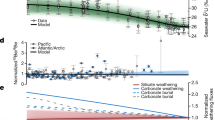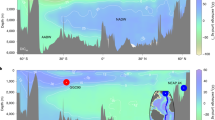Abstract
Throughout the Quaternary period, the Earth’s surface has been subject to large changes in temperature and precipitation associated with fluctuations between glacial and interglacial states that have affected biogeochemical cycling1,2,3,4. However, the effect of these climate oscillations on weathering is debated, with climate modelling efforts using empirical relationships between measures of climate and weathering1,5,6 suggesting minimal changes in global weathering rates between these two climate states7,8. The ratio of the cosmogenic isotope 10Be, which is produced in the atmosphere and deposited to the oceans and the land surface, to 9Be, which is introduced to the oceans by the riverine silicate weathering flux, can be used to track relative weathering fluxes9,10. Here we apply this proxy to marine sediment beryllium records11,12,13,14,15,16 spanning the past two million years, and find no detectable shifts in inputs from global silicate weathering into the oceans. Using climate model simulations of the Last Glacial Maximum17 along with a model for silicate weathering18, we find that there was large regional variability in runoff between glacial and interglacial periods, but that this regional variability was insufficient to shift global weathering fluxes. We suggest that this stability in weathering explains the observation19 that the removal of CO2 from the atmosphere by silicate weathering has been in approximate balance with CO2 degassing over the past 600,000 years.
This is a preview of subscription content, access via your institution
Access options
Subscribe to this journal
Receive 12 print issues and online access
$259.00 per year
only $21.58 per issue
Buy this article
- Purchase on Springer Link
- Instant access to full article PDF
Prices may be subject to local taxes which are calculated during checkout



Similar content being viewed by others
References
Kump, L. R., Brantley, S. L. & Arthur, M. A. Chemical weathering, atmospheric CO2, and climate. Annu. Rev. Earth Planet. Sci. 28, 611–667 (2000).
Godard, V., Tucker, G. E., Fisher, G. B., Burbank, D. W. & Bookhagen, B. Frequency-dependent landscape response to climatic forcing. Geophys. Res. Lett. 40, 859–863 (2013).
Lupker, M., France-Lanord, C., Galy, V., Lave, J. & Kudrass, H. Increasing chemical weathering in the Himalayan system since the Last Glacial Maximum. Earth Planet. Sci. Lett. 365, 243–252 (2013).
Vance, D., Teagle, D. A. H. & Foster, G. L. Variable Quaternary chemical weathering fluxes and imbalances in marine geochemical budgets. Nature 458, 493–496 (2009).
Gaillardet, J., Dupré, B., Louvat, P. & Allègre, C. J. Global silicate weathering and CO2 consumption rates deduced from the chemistry of large rivers. Chem. Geol. 159, 3–30 (1999).
White, A. F. & Blum, A. E. Effects of climate on chemical weathering in watersheds. Geochim. Cosmochim. Acta 59, 1729–1747 (1995).
Munhoven, G. Glacial–interglacial changes of continental weathering: Estimates of the related CO2 and HCO3− flux variations and their uncertainties. Glob. Planet. Change 33, 155–176 (2002).
Bluth, G. J. & Kump, L. R. Lithologic and climatologic controls of river chemistry. Geochim. Cosmochim. Acta 5, 2341–2359 (1994).
von Blanckenburg, F., Bouchez, J. & Wittmann, H. Earth surface erosion and weathering from the 10Be (meteoric)/9Be ratio. Earth Planet. Sci. Lett. 351–352, 295–305 (2012).
von Blanckenburg, F. & Bouchez, J. River fluxes to the sea from the oceans 10Be/9Be ratio. Earth Planet. Sci. Lett. 387, 34–43 (2014).
Carcaillet, J., Bourlès, D. L., Thouveny, N. & Arnold, M. A high resolution authigenic 10Be/9Be record of geomagnetic moment variations over the last 300 ka from sedimentary cores of the Portuguese margin. Earth Planet. Sci. Lett. 219, 397–412 (2004).
Robinson, C., Raisbeck, G. M., Yiou, F., Lehman, B. & Laj, C. The relationship between 10Be and geomagnetic field strength records in central North Atlantic sediments during the last 80 ka. Earth Planet. Sci. Lett. 136, 551–557 (1995).
Ménabréaz, L. et al. The Laschamp geomagnetic dipole low expressed as a cosmogenic 10Be atmospheric overproduction at similar to 41 ka. Earth Planet. Sci. Lett. 312, 305–317 (2011).
Knudsen, M. F., Henderson, G. M., Frank, M., Mac Niocaill, C. & Kubik, P. W. In-phase anomalies in Beryllium-10 production and palaeomagnetic field behaviour during the Iceland Basin geomagnetic excursion. Earth Planet. Sci. Lett. 265, 588–599 (2008).
Carcaillet, J. T., Thouveny, N. & Bourlès, D. L. Geomagnetic moment instability between 0.6 and 1.3 Ma from cosmonuclide evidence. Geophys. Res. Lett. 30, 1792 (2003).
Henken-Mellies, W. U. et al. 10Be and 9Be in South Atlantic DSDP Site 519: Relation to geomagnetic reversals and to sediment composition. Earth Planet. Sci. Lett. 98, 267–276 (1990).
Braconnot, P. et al. Evaluation of climate models using palaeoclimatic data. Nature Clim. Change 2, 417–424 (2012).
Maher, K. & Chamberlain, C. P. Hydrologic regulation of chemical weathering and the geologic carbon cycle. Science 343, 1502–1504 (2014).
Zeebe, R. E. & Caldeira, K. Close mass balance of long-term carbon fluxes from ice-core CO2 and ocean chemistry records. Nature Geosci. 1, 312–315 (2008).
Reheis, M. C., Adams, K. D., Oviatt, C. G. & Bacon, S. N. Pluvial lakes in the Great Basin of the western United States—a view from the outcrop. Quat. Sci. Rev. 97, 33–57 (2014).
Foster, G. L. & Vance, D. Negligible glacial–interglacial variation in continental chemical weathering rates. Nature 444, 918–921 (2006).
Burton, K. W. & Vance, D. Glacial–interglacial variations in the neodymium isotope composition of seawater in the Bay of Bengal recorded by planktonic foraminifera. Earth Planet. Sci. Lett. 176, 425–441 (2000).
Christl, M., Lippold, J., Steinhilber, F., Bernsdorff, F. & Mangini, A. Reconstruction of global Be-10 production over the past 250 ka from highly accumulating Atlantic drift sediments. Quat. Sci. Rev. 29, 2663–2672 (2010).
Gourlan, A. T. et al. Northern Hemisphere climate control of the Bengali rivers discharge during the past 4 Ma. Quat. Sci. Rev. 29, 2484–2498 (2010).
Lisiecki, L. E. & Raymo, M. E. A Pliocene–Pleistocene stack of 57 globally distributed benthic δ18O records. Paleoceanography 20, PA 1003 (2005).
Bar-Matthews, M., Ayalon, A. & Kaufmann, A. Timing and hydrological conditions of Sapropel events in the Eastern Mediterranean, as evident from speleothems, Soreq cave, Israel. Chem. Geol. 169, 145–156 (2000).
Stumpf, R., Frank, M., Schonfeld, J. & Haley, B. A. Late Quaternary variability of Mediterranean Outflow Water from radiogenic Nd and Pb isotopes. Quat. Sci. Rev. 29, 2462–2472 (2010).
Willenbring, J. K. & von Blanckenburg, F. Long-term stability of global erosion rates and weathering during late-Cenozoic cooling. Nature 465, 211–214 (2010).
Dai, A. & Trenberth, K. E. Estimates of freshwater discharge from continents: Latitudinal and seasonal variations. J. Hydrometeorol. 3, 660–687 (2002).
Zhang, P. Z., Molnar, P. & Downs, W. R. Increased sedimentation rates and grain sizes 2–4 Myr ago due to the influence of climate change on erosion rates. Nature 410, 891–897 (2001).
Acknowledgements
We are grateful to N. Hovius, G. Govers, G. Haug, W. Rahaman, P. Valdes, D. Scherler and G. Feulner for comments and discussion. We gratefully acknowledge the international climate modelling groups participating in CMIP5/PMIP3 for producing and making their model output available for analysis, and PCMDI (supported by the US Department of Energy) for distributing the data. The CMIP5/PMIP3 database was last accessed in August 2014. K.M. acknowledges support from the US NSF (EAR-1254156).
Author information
Authors and Affiliations
Contributions
F.v.B. designed the study, compiled 10Be/9Be data, interpreted data and wrote text; J.B. processed core data, interpreted data and wrote text; D.E.I. processed climate model data, interpreted data and wrote text; K.M. designed the weathering model, interpreted data and wrote text.
Corresponding author
Ethics declarations
Competing interests
The authors declare no competing financial interests.
Supplementary information
Supplementary Information
Supplementary Information (PDF 1741 kb)
Supplementary Information
Supplementary Information (XLSX 19 kb)
Supplementary Information
Supplementary Information (XLSX 29 kb)
Rights and permissions
About this article
Cite this article
von Blanckenburg, F., Bouchez, J., Ibarra, D. et al. Stable runoff and weathering fluxes into the oceans over Quaternary climate cycles. Nature Geosci 8, 538–542 (2015). https://doi.org/10.1038/ngeo2452
Received:
Accepted:
Published:
Issue Date:
DOI: https://doi.org/10.1038/ngeo2452
This article is cited by
-
Holocene melting of the West Antarctic Ice Sheet driven by tropical Pacific warming
Nature Communications (2022)
-
Spatial variations of authigenic beryllium isotopes in surface sediments of the Antarctic oceans: a proxy for sea ice dynamics and sedimentary environments
Geosciences Journal (2022)
-
Rapid coupling between solid earth and ice volume during the Quaternary
Scientific Reports (2021)
-
Neogene cooling driven by land surface reactivity rather than increased weathering fluxes
Nature (2019)
-
New isotope constraints on the Mg oceanic budget point to cryptic modern dolomite formation
Nature Communications (2019)



